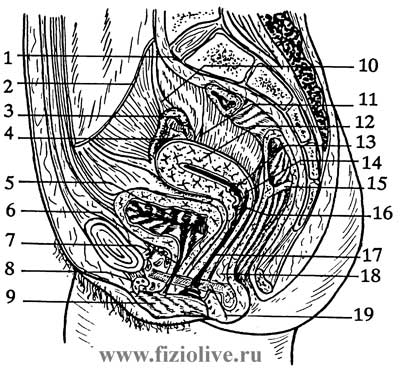
| HOME | MENU | DOCS | SEARCH |
Translations of articles in the English language
is in automatic mode, the original version
of the article in Russian - here
The content of the article "exercise therapy in gynecology and obstetrics":
Climacteric syndrome (menopause for women)
Wrong position of the genitals
*Initial position - I. p.
Reproductive system adult female includes internal organs - ovaries, fallopian tubes, uterus, vagina, and external genitals - the vulva, large and small sex lips, clitoris, the entrance of the vagina (see Fig. The middle section of the female pelvis).
The middle section of the female pelvis

1 - ledge, Cape, 2 - round ligament of the uterus; 3 - ovary, 4 - own ligament of the ovary, 5 - bladder 6 - pubic-vesical ligament, 7 - urethra, 8 - clitoris 9 - low sexual lip, 10 - fallopian tube, 11 - ureter, 12 Queen, 13 - opening of the uterus, 14 - posterior lip of cervix, 15 - transverse fold of the rectum, 16 - posterior part of vaginal fornix, 17 - lateral vaginal fornix, 18 - recto-vaginal partition, 19 - large (bartolino) glands of the vestibule of the urogenital diaphragm
Female reproductive organs are associated with all body systems and are in mutual dependence. Infectious diseases, diseases of the cardiovascular, nervous, digestive, endocrine and other systems affect critical functions of the sexual apparatus of women, and the latter, in turn, affect the state of the organism as a whole.
The use of exercise in the treatment of gynecological patients due to the nature and degree of morphological changes and functional disorders, age-related peculiarities of physical development and adaptation to exercise.
Therapeutic exercises helps to improve blood and lymph circulation and reduce venous stasis in the pelvic cavity, resorption of exudate and infiltration, evacuating the decay products from foci of inflammation. These phenomena happen due to improve overall body tone, blood oxygenation, and improvement of redox processes.
Note: I. p. - initial position; TM - the pace is slower; TA -the average pace.
An approximate complex of physiotherapy in gynecological diseases
1. I. p. is on all fours. Alternate the lead foot back. TC. 5-8 times.
2. I. p. - sitting, legs shoulder-width apart. Tilts to the right and left leg. TC. 5-7 times.
3. I. p. - sitting. To bend, to sit down. TC. 4-6 times.
4. I. p. - lying on your back with your legs bent. Dilution and mixing of the feet. TC. 6-8 times.
5. I. p. - lying on his stomach. Alternate the lead foot up. TC. 5-7 times.
6. I. p. - lying on your back. To sit down-to lie down. TC. 5-8 times.
7. I. p. - sitting, hands in front of chest. Torso twists left and right. TC. By 5-8 times.
8. I. p. - sitting. Tilts to the left and right leg. TC. By 5-7 times.
9. I. p. - lying. Lifting the legs. TC. 8-10 times.
10. I. p. - the same. Breeding to the sides of the feet and hands. TC. 6-8 times.
11. I. p. - lying, hands behind his head. The rotation of the feet. TM. 4-6 times.
12. I. p. - lying. To sit up, clasping his knees; return to I. p. TS. 6-8 times.
13. I. p. - standing. The slopes of the left and right. TC. By 8-10 times.
14. I. p. - standing, hands behind. Bend - inhale; lean forward, hands to relax - exhale. TC. 6-8 times.
15. I. p. - standing, hands up. Sit down, hands forward. TC. 5-7 times.
16. I. p. - standing, hands "in lock". The rotation of the torso. TC. 5-8 times.
17. I. p. - standing by the chair. Abduction of the right leg to the side. It is the same with the left foot. TM. By 6-8 times.
18. I. p. - lying. "Bicycle". 10-15 C.
19. I. p. - sitting on the heels. To take the knee-elbow position; to return to I. p. TS. By 6-8 times.
20. I. p. - the emphasis on the elbows, legs straight. To kneel; to go back to I. p. TS. 5-8 times.
21. I. p. - the same. Lie on belly; to return to I. p. TM. 6-8 times.
22. I. p. - sitting, hands on knees. Abduction knee to the side; return to I. p. TS. 8-10 times.
Amenorrhea - absence of menstruation for several months. May be physiological - in period before full puberty, during pregnancy, lactation and menopause, and abnormal if the rhythm of menstruation is not established during the year. Often amenorrhea occurs in athletes. This is connected with significant physical and psychoemotional loads. After the cessation of sports menstrual cycle is restored.
Amenorrhea LH shown (see Fig. Approximate set of exercises amenorrhea), massage, physical training (Cycling, skiing, swimming, games, boating, etc.). Performed vibratory massage, sauna (bath), hardening, fortification, diet therapy, phytotherapy, acupuncture, etc.
Approximate set of exercises amenorrhea
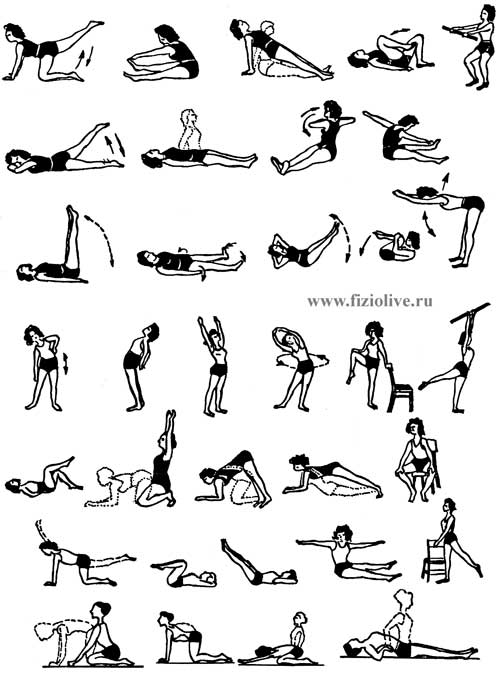
Are relatively frequent disorders. The pain usually occurs before the beginning of the cycle and lasts 1-2 days of menstruation. There is often nausea, vomiting, sweating, spastic constipation, headache and other disorders that violate the General condition and capacity for work women.
LH shown (breathing exercises), massage, walking, taking sedative medications, skiing, etc.
Climacteric syndrome - a weakening of the physiological mechanisms of adaptation is associated with age-related involutional restructuring of the female body.
Climacteric syndrome are recommended LG, massage, walks in the woods (the Park), along the banks of the river (sea), Jogging (at first, alternating walking and Jogging), Cycling, skiing, swimming, coniferous-salt bath, shower (radial, circular, rain, etc.), tempering procedures, games, etc.
Infertility - inability to conceive - it happens when the following diseases of the genital organs: inflammation of the fallopian tubes, accompanied by the violation of their patency, complication of peristalsis and damage mertzatelnogo epithelium, endometrium, especially in combination with inflammation of the tubes, endocervicitis, colpitis; chronic authoritah and perioophoritis subject to the disturbances of ovulation; the wrong position of the uterus, especially in combination with inflammation of the fallopian tubes, tears of cervix and perineum, prolapse and loss of sexual organs, scar adhesions (synechiae) within the uterine cavity, formed after coarse curettage (abortion), etc.
Infertility may occur in connection with infantilism, diseases of the endocrine glands, malnutrition, etc.
Rehabilitation of infertility shows: LH, physical activity (walking, Jogging, skiing, Cycling, games, etc.), vibration massage, tempering procedures (contrast shower, bath, sauna, etc.), pelvic massage, etc.
Wrong position of the genitals - a strong deviation from their normal state, usually accompanied by pathological phenomena. Retroflexa - bend the body of the uterus posteriorly; retroverse - the body of the uterus is tilted backwards, neck - forward; retrodeviation of the uterus - often found combination of retroflexion and retroversion.
Pathological deviation of the uterus and bend it back contribute to inflammatory diseases, injuries of pelvic organs, abnormalities of the uterus, decreased tone of the ligamentous-muscular apparatus of the uterus. Retroflexion of the uterus may be due to the weakening of the abdominal muscles and pelvic floor, aided by repeated pregnancy, childbirth, surgical intervention during delivery, perineal tears, slow involution of uterus, puerperal infection, etc.
When the wrong position of the uterus are recommended LH, pelvic massage, swimming, walking in the forest (Park, Park), Biking, swimming, boating, sauna (sauna), etc.
Ptosis and prolapse of the uterus and vagina occurs when heavy physical work, constipation, insufficiency of the pelvic floor muscles as a result of injury of the perineum during childbirth. Predisposing moments: early physical work in the postpartum period, frequent childbirth, retroverse of the uterus, infantilism, etc.
Ptosis and prolapse of the uterus and vagina often occurs in elderly women with involutional processes in the genital organs. One of the main factors affecting the position of the uterus - intra-abdominal pressure, which is influenced by the position of the body.
Change in intra-abdominal pressure when changing body position is determined by the change in relative position of internal organs and the degree of muscle tension of the abdominal wall.
Intra-abdominal pressure is also regulated by the friendly function of the diaphragm, anterior abdominal wall and pelvic floor, which are the supporting apparatus intrapelvic organs. With good functional status of pelvic floor muscles they have adequate resistance to the abdominal press, whereupon the uterus and vagina do not fall below normal limits.
With a small prolapse of the uterus shows therapeutic exercises (see Fig. Approximate complex LH in the omission of the uterus), vibratory massage, whirlpool (water temperature 27-29В°C), swimming in flippers, spatulas, dumbbell exercises (in supine), etc. Classes at the gym (in the supine position with raised pelvis) followed by taking a contrast shower.
Approximate complex LH in the prolapse of the uterus
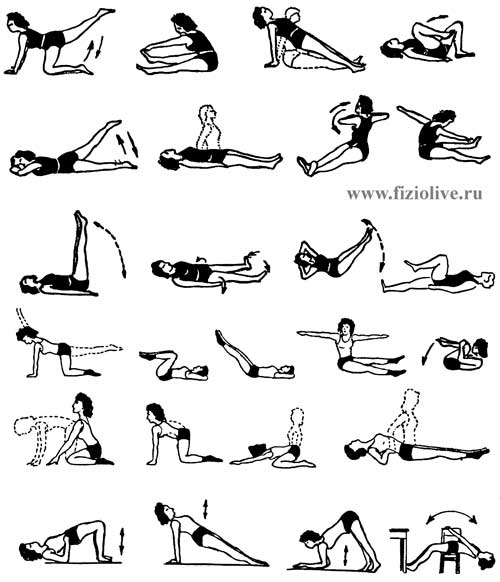
The postpartum period is characterized by the reverse development of changes related to pregnancy and childbirth. However, the postpartum period is characteristic of the process and progressive nature (lactation).
Adaptation to new conditions after the birth of a child changes the body, particularly the reproductive system, the most heavily committed during the first - second weeks of the postnatal period.
Shown therapeutic exercises (see Fig. Approximate complex LH in the postpartum period), massage, contrast shower, walking, etc. the Use of LH allows an earlier date to normalize the functional status of women to prevent postpartum complications and faster adapt to living conditions after discharge from the hospital.
Approximate complex LH in the postpartum period
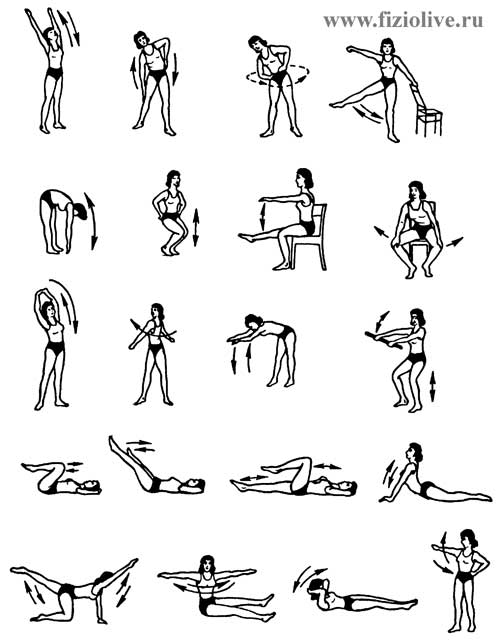
During pregnancy and in the postpartum period may show up a variety of breast disease.
Hypogalactia insufficient milk production. The best way to maintain the ability of lactation is the act of a suckling child.
Trauma, poor diet and other factors can cause changes in the function of mammary glands from slight decrease in lactation until complete and persistent disappearance of the milk.
Prevention of hypogalactia. First of all a young mother needs to adhere to the correct technique of breastfeeding, contributing to the development molokootdelenia reflex irritation of the nipple; to respect the norms of hygiene; diet (vegetables, fruit, vitamins, mineral substances, meat, fish, eggs), water (adequate fluid intake), walking, douche, UFO, self-massage neck, arms, breast, perform morning exercises, etc.
Cracked nipples the violation of the superficial layer of the skin of the nipple, accompanied by pain, sometimes so strong that it interferes with the rhythm of breastfeeding. Main causes of cracked nipples - improper design of feeding baby, pumping milk inept, improper care nipples, failure to comply with obseravations events. The nipple becomes swollen, hyperemic, sometimes sores appear. Around the affected teat often there is more or less hyperemia of the skin. Touching the nipple, and the sucking causes pain. The cracks are infected with germs from the skin of the woman, with her hands, clothes, finally, from the mouth of the child. Feeding maintains a constant maceration of the skin of the nipple, which disrupts the healing process of fractures.
For treatment, along with the hygiene of the breast shown: UFO the nipple area and breast cancer 2-3 biodozy, the day after, baths with potassium permanganate to nipple with water temperature of 38-39В°C, daily; massage neck area and mammary glands; dressing with 5-10% aqueous solution of mumiye on the breast; a daily shower and wash the mammary glands, thorough hand washing before feeding. Recommended expressing milk and feeding the baby through the nipple. Physical therapy includes respiratory and General developmental exercises, tempering procedures, fortified with vitamins, herbal medicine.
Massage when feeding is for the prevention of mastitis, stimulation of lactation. First massage the reflex zones (cervical-thoracic spine), then the mammary glands. Massage performed before feeding, washing hands with warm water and soap. Nails must be cut short.
Functional incontinence can be related to the severe traumatic impact on the genitourinary system, the result of stretching of the posterior wall of the urethra, prolapse of the anterior wall of the vagina. Urinary incontinence may occur several months after birth. Occurs more often in women with prolapse of the anterior wall of the abdomen and multiparae women.
LH shown (see Fig. Approximate complex LH in functional urinary incontinence), massage, swimming, dumbbell gymnastics, Cycling, skiing, classes at the gym, hardening, etc.
Approximate complex LH in functional incontinence
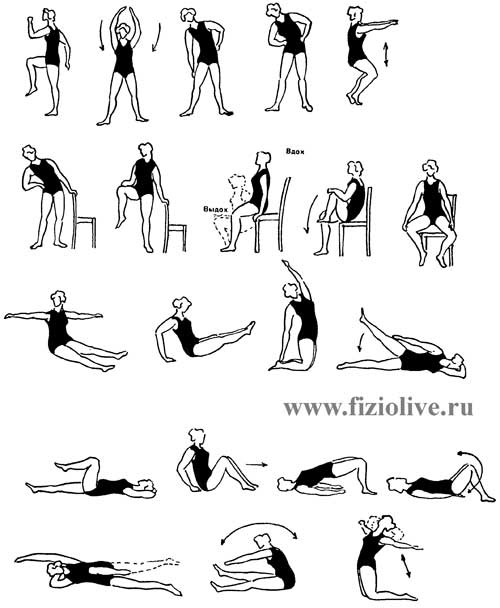
Physical exercise has beneficial impact on pregnancy, Thai and delivery and post-Natal. During pregnancy there is a transformation of the body that is sometimes accompanied by phenomena of early toxicosis, manifested by nausea, vomiting, dizziness, taste perversion, loss of appetite. These phenomena are much less pronounced when the systematic physical exercises, as dosed physical activity has a positive effect on the autonomic nervous system. Exercise increases overall health, the cause vigor, vitality, improve sleep and appetite, which greatly helps to restore the lost equilibrium between the various organs and systems.
During pregnancy is prefer walks in the woods (the Park), massage, gymnastic exercises. Exercise undesirable, as they lead to fetal hypoxia, significant stresses abdominal muscles, pelvic floor and possible vibrations of the body.
Pregnant useful breathing exercises, exercises for strengthening of abdominal muscles, perineum, back, and relaxation exercises. Are all the references, but still mostly - prone position (especially exercises for the muscles of the perineum, abdomen, back, legs, breathing exercises, etc.). Dynamic exercises should be combined with breathing and relaxing exercises.
As a result of gymnastics pregnant woman needs: 1) to control our breathing, which is necessary for the proper management of childbirth, as the ability to make a deep breath, hold your breath for the signal, the midwife not only accelerates the recovery process of childbirth, but also is a prevention of laceration of the perineum, and the intensification of respiratory function improves oxidation-reduction processes, and this influences the development of the fetus; 2) strengthen your abdominals and pelvic floor, which is very important for the favourable course of childbirth, but also for the prevention of postpartum complications, including weakening of the abdominal wall, prolapse of internal organs, etc.; 3) increase the mobility of the sacroiliac joints and hip joints that facilitates the act of birth; 4) strengthen body muscles, particularly your abdominals, pelvic floor and back muscles, which bear the greatest burden during pregnancy and childbirth.
All women with normally proceeding pregnancy should exercise: walk (a walk in the woods, the Park), doing exercise (complexes given below, perform them several times (2-3) per day), take a contrast shower and other tempering procedures. Control over activities, their dynamics is made by the doctor of female consultation and the doctor of physical therapy.
With increasing gestational age changes the reaction of women to physical exercise, and therefore it is necessary to modify the complexes of gymnastic exercises (some exercises to replace other, to introduce new).
During pregnancy starting at 12 weeks, there was an increased venous pressure in the lower extremities. This is due to the gradual pressure of the growing uterus on the pelvic veins, which impedes the outflow of blood from the lower extremities. With the same link the appearance of puffiness on the legs in women and blew in the later stages of pregnancy, and some starts varicose veins. In such cases, you should include exercises for the lower extremities in I. p. lying, some of them are performed with a slightly raised feet; it also involves massage of the back, waist and legs, the cold shower.
Pregnancy is divided into periods taking into account the physiological changes that occur in pregnant women, although between them and there are no sharp boundaries.
The first period of pregnancy (before 16 weeks).
This period is characterized by a complex restructuring of the body in connection with the conception, so care is needed in selection of exercises, dosage and application of exercises that increase intra-abdominal pressure.
Recommended exercises for training the abdominal muscles and the perineum, breathing exercises. You should not include jumping, jumps, avoid straining, etc., which cause a sharp increase in intra-abdominal pressure, the shaking of the body. In the main section, the exercises from initial position sitting, supine and side lying. In conclusion - relaxation exercises, breathing exercises. Duration of studies - 15-25 minutes, two times a day.
Approximate complex LH in pregnancy up to 16 weeks
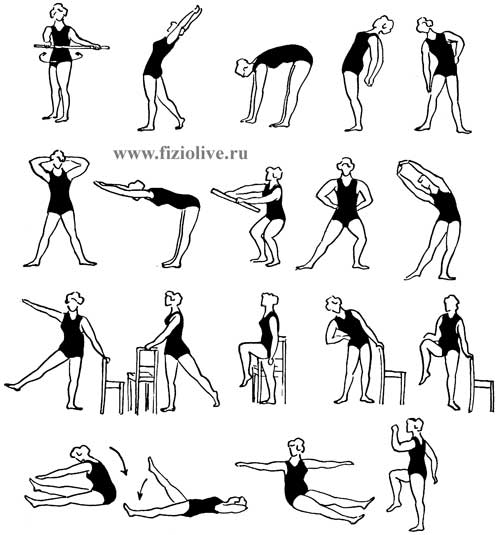
1. I. p. - standing. Torso twists left and right. TC. By 6-8 times.
2. I. p. - the same. Alternate the lead leg back, hands up - inhale, hands down - exhale. TM. By 4-6 times.
3. I. p. - the same. Hands up - inhale, bend forward, exhale. TM. 3-6 times.
4. I. p. - the same. To bend, the hands to take back - inhale, hands forward, to straighten up, exhale. TC. 4-6 times.
5. I. p. - the same. Trunk bending left and right. TM. By 6-8 times.
6. I. p. - standing, hands behind his head. Tilt forward, hands to straighten; to return to I. p. TS. 4-6 times.
7. Squats. TC. 5-7 times.
8. I. p. - standing, hands on his belt. Step toward-forward. Alternately right and left foot. TC. By 5-7 times.
9. I. p. - standing, hands at the top of "the castle". The slopes of the left and right. TM. By 6-8 times.
10. I. p. - standing by the chair. In turn the movement of legs and arms to the side. TC. By 4-6 times.
11. I. p. - the same. Alternate the lead foot back. TC. By 6-8 times.
12. I. p. - the same. Alternate leg curl. TC. By 6-8 times.
13. I. p. - the same. The slopes of the left and right. TM. By 4-8 times.
14. I. p. - the same. Alternating abstraction bent legs in the side. TM. By 6-8 times.
15. I. p. - sitting. The forward bends. TM. 3-5.
16. I. p. - lying. Alternate abduction straight leg. TM. By 4-6 times.
17. I. p. - sitting. Turns to the side. TC. By 5-7 times.
18. Walking on the spot. TM. 20-30 s.
The second period of pregnancy (weeks 17-31.)
During this period, special attention is paid to exercises to train the abdominal muscles, back muscles, pelvic floor, increase mobility in the joints of the pelvis, the spine.
Exercises are done from the original provisions of sitting, standing, bed on the back side. The complex includes dynamic breathing and relaxation exercises of the muscles that run several times a day, take a contrast shower. Duration of studies - 15-35 min.
Approximate complex LH in pregnancy 17-31 weeks
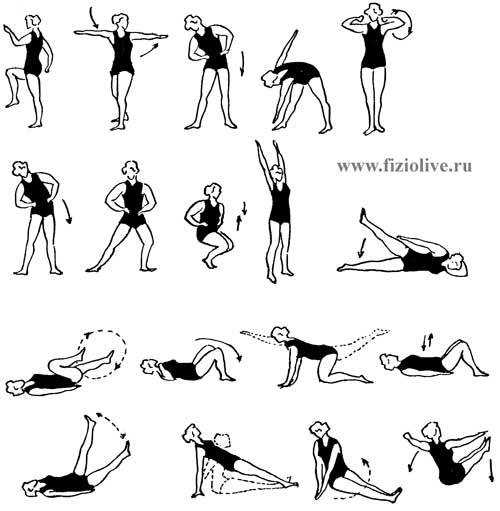
1. Walking on the spot. TC. 30-60.
2. I. p. - standing. Turning the torso to the side. TM. 5-6 times.
3. I. p. - the same. Inclinations in the parties. TM. By 4-6 times.
4. I. p. - the same. Tilts to the right and left leg. TM. By 3-5 times.
5. I. p. - standing, hands to the shoulders. The rotation of them. TC. 4-8 times.
6. I. p. - standing. The slopes of the left and right. TM. By 4-6 times.
7. I. p. - the same. Step to the left (right) alternately. TC. By 4-6 times.
8. I. p. - standing, hands on his belt. Squat - exhale. TM. 4-8 times.
9. I. p. - standing. Hands up (on 2 accounts) and down. TM. 3-6 times.
10. I. p. - lying on your side. Alternate the lead leg up - inhale; return to I. p. exhale. TM. By 4-6 times.
11. I. p. - lying. "Bicycle". TM. 5-10 times.
12. I. p. - lying, legs bent. Turns foot left and right. TC. By 6-8 times.
13. I. p. - standing on all fours. Take turns to take the arm and leg up. TC. By 4-6 times.
14. I. p. - lying, legs bent. Raise the pelvis up. TM. 3-5.
15. I. p. - lying. Lift alternately right and left foot. TC. 5-6 times.
16. I. p. - sitting. Trunk bending forward. TM. 4-6 times.
17. I. p. - sitting. Lift your feet, arms at sides. TM. 5-7 times.
The third period of pregnancy (32-40 weeks).
In this period due to the growing uterus changes the position of the abdominal organs, which makes their function limited to the mobility of the diaphragm, difficulty breathing, there is a tendency to constipation. Some women observed phenomenon of toxemia, swelling of the lower extremities. Due to the difficulty of the blood and lymph circulation easily have stagnation.
This precludes the execution in this period exercises associated with straining effort, breath, and continuous static tension, etc. In this period recommended massage back, waist and lower limbs (when performing leg should be slightly raised), a cool shower (lower extremities). Exercises should help to reduce congestion, to relax the muscles of the lower extremities. Required classes are breathing exercises and exercises that improve the mobility of the sacroiliac joints. Duration of studies - 15-35 min.
The complex of gymnastic exercises it is desirable to perform the music. After take a shower or make a rubbing.
Approximate complex LH in pregnancy 32-40 weeks
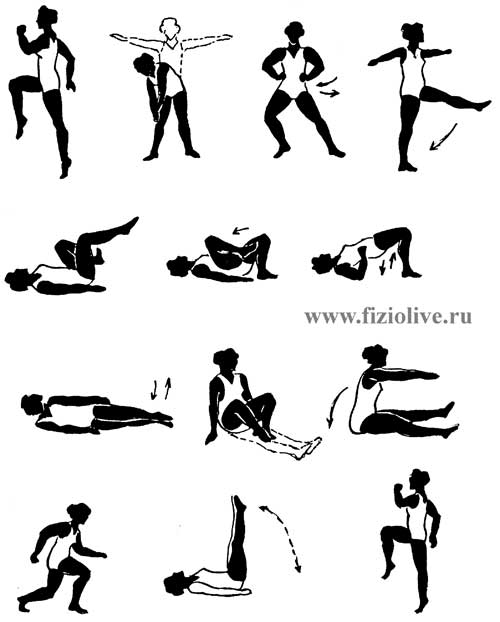
1. Walking on the spot. TC. 30-40 s.
2. I. p. - standing. Tilts to the right and left leg. TM. By 4-7 times.
3. I. p. - the same. Step forward and to the side. In turn. TC. 5-6 times.
4. I. p. - the same. Alternate the lead foot forward, hands to the side. TC. By 4-6 times.
5. I. p. - lying. "Bicycle". TC. 10-15 s.
6. I. p. - lying, legs bent at the knees. To dissolve feet in the parties and be reduced. TM. 6-8 times.
7. I. p. - lying, legs bent. Raise the pelvis up. TM. 4-6 times.
8. I. p. - lying on your side. Alternate lead legs to the side. TC. By 6-8 times.
9. I. p. - sitting. Bend legs, straighten. TC. 6-8 times.
10. I. p. - lying. Stand up, sit down. TM. 3-5.
11. Walking in a crouched position. TM. 15-30 s.
12. I. p. - lying. Alternate lifting of direct feet. TM. 4-6 times.
13. Walking on the spot. TM. 20-30 s.
V.I. Dubrovsky,
Academician of the Russian Academy of Natural Sciences,
IANPO and the New York Academy of Sciences,
Doctor of Medical Sciences, Professor,
A.V. Dubrovskaya, pediatrician
It is available for the original version
of the article in Russian
<< Previous: Exercise therapy for injuries and diseases
We recommend that you look at the popular sections of the site myvaleology.com: MENU with a description of the sections | |||
| SOCIAL | DONATION | MY DIET | MY SPORT |

|
Release all4e8 |
||
Copyright © VZOJ 2023. All rights reserved. When reprinting or quoting myvaleology.com materials please put a link to the site myvaleology.com :
<a href="https://myvaleology.com">Healthy lifestyle</a>